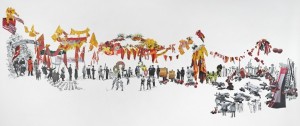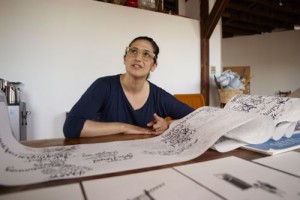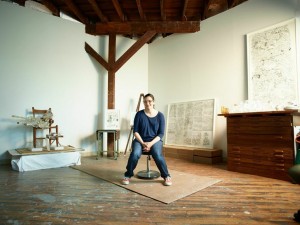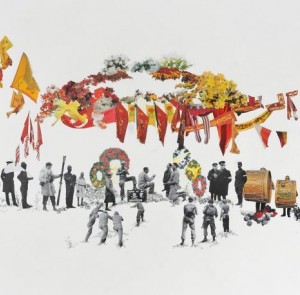It Begins with Words: In the Studio with Rachel Farbiarz
Rachel Farbiarz is a public intellectual whose medium is visual art. Before devoting her career to art making, she worked as a lawyer focusing on the civil rights of prisoners, particularly those on death row. In this interview, Rachel takes ZEEK readers into the intellectual and physical space of her creative process.
About this Series: The creative life begins in the details. It starts with the way you wake up, go through your morning rituals, and engage with the materials in your studio. It is a daily pursuit; a physical comingling that ends, only partly, when the artwork is deemed complete. Religious life also takes place in the details, often dictating how we wash, eat, dress, and engage with the physical world. Centered on interviews, this ZEEK series asks artists working today to explore how Judaism, faith, religious ideas, or even a kind of religious antagonism relates to their studio practice.
Tamara: How did you decide to become a professional artist?
Rachel: It didn’t feel like a choice. It felt completely necessary. It never occurred to me that I could or would be an artist. It just didn’t seem like an option. And I had other interests. I studied political philosophy in college and then became invested in working on the rights of prisoners.
Tamara: How did you become invested in fighting for the rights of prisoners?
Rachel: Through my senior college thesis. I wanted to write about how people deal with changing ideas of self, how we accept or don’t accept that people can have a radical change. What I settled on was the case of this horrific killer who had changed profoundly in prison and was up for execution in Texas. I wanted to think through how people understood or rejected her changed self and how that affected conclusions about what kind of punishment she should face. After college, I interned at prison rights organizations. From there I went to law school, clerked for a year, and then eventually worked at the Prison Law Office in California. The office litigated civil rights law suits about conditions of confinement in California.
Tamara: Did you have any creative outlets during this time?
Rachel: This was a huge issue for me. I found working as a lawyer so internally consuming that I had very limited capacity for other creative endeavors. During this time, I had meager creative output — nothing substantial. I found it very difficult to switch between my working, lawyering mode and my creative one. Temperamentally, this was very challenging for me and I was increasingly dissatisfied with my lawyering work because of it.
Tamara: How did you return to creating art?
Rachel: I was moving from California to Washington, DC, and I knew I needed a change. But I didn’t arrive in DC with the intention of being an artist. I came with the intention of writing about my grandfather. I deeply felt the need to make something that would be a testament to his life. Not that he would have thought this was a worthy endeavor. In fact, he explicitly told me that doing so was a silly pursuit. But I felt strongly that it was necessary.
My grandfather was a tough man. He looked like Popeye, with huge forearms and thick, permanently dirty and cracked fingernails. He was rough around the edges, but joyful. When I was young, he worked as a New York City cab driver and before that as a construction worker, among many other kinds of manual work. He was from Lodz, Poland., With the exception of a half-sister, his whole family was killed in the Holocaust. As an adolescent he left the ghetto before it was totally sealed and ran. He made his way through Europe, Central Asia and Northern Russia riding trains, smuggling and working — in labor camps and elsewhere. He met my grandmother in Uzbekistan, and eventually they made a life together.
His story — and particularly the role of work and dislocation in it — felt like the key to understanding my family and myself. And I think that is actually why I couldn’t write it. So all that being said, while I said to myself and others that I was writing, I was really starting to make things, to work more visually.
Tamara: Had you made things before?
Rachel: Yes, I had been drawing my whole life. Probably the most important art learning I did was in high school. I commuted to a school in New York City, located around the corner from the Metropolitan Museum of Art. In ninth grade, on Fridays, I would go to the museum with a classmate who had an amazing, native talent for drawing. We would draw the sculptures in the European collections; and he drew in a manner I had never before seen. The depth and shadow of his subjects created the line. His drawings looked like Old Masters’ drawings, but they weren’t artifacts. I saw his hand connect with the pencil, and the pencil with the paper to make this amazing and beautiful thing that was just lines that hadn’t been there minutes before. It was revelatory for me. I knew both that I wanted to and that I could do that. My friend left our school after ninth grade, but I continued to go the Met on Fridays to draw throughout high school. Often, when I was there, I totally lost track of time. I would be shocked that hours had gone by while I had been so absorbed. This was a crucial part of my learning both how to make things and how to immerse myself in the process of doing so.
Tamara: How did you start the process of creating after such a long hiatus?
Rachel: When I moved to DC, my father gave me money to buy paints. He paints as a hobby and, through the years, had always encouraged me to keep up my drawing and creative output. It wasn’t that my father wanted me to be an artist. On the contrary, I’m pretty sure both my parents found my decision to give up lawyering to be, at the very least, troubling. Still, my father’s nudge had an impact. I now had paper, paints, pencils and pens in a room in my apartment, and I just started making things. Maybe I started making in earnest to justify the money I had spent on the paints. I still thought that what I was “really” doing was writing — or at least trying to. I didn’t show my work to anyone, but I treated it seriously in its own way. As time went on, I found myself increasingly drawn to making visual work. Still, I didn’t think of myself as an artist. I thought of myself as someone trying to figure out what I was doing.
After my daughter was born I was home with her until she was about 10 months. Around then, I just had a break. I knew I wanted to get back to my work, but it was a strange and uncomfortable feeling. People go back to a job or to a profession they have built: I just had some drawings in my filing cabinet. I felt so pathetic. How would I do this thing that wasn’t even a thing? There was no “there” there. How do you pay for the childcare to do something that doesn’t exist?
It was a difficult time in my life. I felt so confused and trapped. And I knew that if I was going to leave my daughter to work, it had to be worth it. It — and I — had to be serious and real about it. At that point I experienced a real shift to a new level of seriousness.
Tamara: What did that new level of seriousness look like?
Rachel: In the beginning, it just felt desperate. I felt like a failure and I hadn’t even started. I had a good talking-to from a friend who is a poet; and she made me realize that I had to put myself out there. She really spurred me to conceptually change how I thought about my work. I couldn’t continue to make work just to put it in a drawer. I had something akin to a responsibility to engage with it publicly. I didn’t feel like I had any pride about my work; but whatever it was — I had to swallow it. No one owed me anything. It was all on me.
So, I entered myself into a regional, non-juried show called Artomatic. Hundreds of artists in the greater DC area participate in this sprawling arts festival. I created a conceptual piece called The Genizah Project, which served as a receptacle for things, writing, letters, diaries, objects that people had long held onto and were ready, at long last, to part with.
I got very lucky: my piece was blogged about and local public radio did a story about it. I was just in this mode of putting myself out there. And because of my work at Artomatic a local gallerist, Margaret Heiner and her colleague Elizabeth Parkman, found me and started working with me. They believed in me and asked me to make an installation for an upcoming group show. From then on I worked really hard. I told myself that I was going to treat making art like work and I was not going to apologize for it. I was going to work as I hard as I did at lawyering. I was going to give it my all. I did; and within the year, Margaret offered me my own show.
Tamara: What does your studio look like?
Rachel: I love my studio. It’s in an old brick building that I believe originally had some kind of industrial function; and in the 1970s it was converted into a warren of artists’ studios. I’m on the top floor, which means I have wonderful, mostly northern light and I can see sunsets and treetops. It also means though that tiny debris is constantly raining down from the ceiling and will eventually coat whatever has been left out. If I won’t be in the studio for a few days, I cover any work with plastic to protect it from the shmutz fallout.
I’ve got a lot of white space on the walls, where I’ll hang up in-progress work. I have a drafting table that is being held together by bungee cords and a huge old wooden laboratory table that my husband rescued from a closing school in Brooklyn well over a decade ago. I have lots of teeny tiny gift boxes and envelopes that are filled with groupings of images that I have cut out for my collage work. The beating heart of my studio is the collection of hundreds of old books that I use as source imagery — either from which to draw or, more commonly, from which to cut images. The books ground and incite me. I am constantly flipping through them for ideas, references and reminders of what I find interesting, beautiful and provocative. It gets really messy. I can’t keep the studio clean when I am in the middle of a piece.
Tamara: Can you describe how you work on a piece?
Rachel: When I am working on a piece it feels quite academic to me. I feel like I am writing a paper, building an argument, telling a story. In the same way that a well-wrought essay will feel architecturally correct, that there is a logic to it, a pacing to it, a narrative to it. I feel similarly about my work. I feel like there is an internal logic to my work that needs to be hammered out through the creating process.
If things feel slow when I get to the studio, I will make parameters for myself. For example, for a while, I did a very quick drawing everyday and wouldn’t allow myself to revisit it the next day. I gave myself a certain bloc of time to do it and then I just did it. More often, though, things don’t feel slow in the studio. I’ll open the studio door and I won’t even take off my coat: I just dive in. I can’t wait to see the piece that I’ve been working on. I want to fix things that are wrong with it. I want to make it feel right. I was particularly like this with the piece Memorial Hill. I was obsessed.
Tamara: Can you tell us more about Memorial Hill?
Rachel: The genesis of the piece is a historical event. But the piece isn’t about the event; the imagery instead resonates with it. The event drove the imagery, but eventually the piece took on a life of its own. I wasn’t telling a story so much as invoking something resident within the event.
Tamara: What was the historical event?
Rachel: The Christmas Truces of World War I. In the early years of the war spontaneous, organic truces broke out all along the western front for Christmas. The two armies were hunkered down in their horrible trenches and something broke down — or more appropriately, was put together. The manifestation of the temporary fraternity was different along the front. In some places, soldiers caroled across no-man’s land to another. In some they played soccer between the trenches, exchanged gifts, smoked cigarettes together. They buried the dead whose corpses had been left to rot in no-man’s land. It was a profoundly affecting event for those who experienced it, with many soldiers writing home about it.
The fact of the Christmas Truces is astounding to me. It’s so crazy. These men were engaged in brutal, brutal warfare, and then all of a sudden there was this amazing, humane phenomenon. That is the germ of the piece. It tries to reenact the bizarre combination of grotesque barbarism, garish pomp and painful humanity that are wrapped up in war.
Tamara: Can you explain how you move from this historical event to an artwork?
Rachel: I had an idea of the layout of the piece. I wanted a long, pompous parade line. And from there, it became a quasi-academic, obsessive pursuit of making sure the characters and objects in this parade line work well together. That their positioning felt visually logical — with a consistency of tone, pacing, color and posture. I needed to feel that the images were advancing the narrative and hewing to a certain mood. There is a mechanics to putting together a piece that I get very into.
And as I get deeper into a piece, it always presents its own necessities. For instance, in Memorial Hill, I got to a point where I knew I needed more source material for Soviet iconography, so I had to go back and riffle through the shelves of many bookstores to find those images. I just knew I needed those images. So, in many ways it feels like I am working out a problem that actually has a solution.
Tamara: Do you feel like you are working out a moral or ethical problem?
Rachel: A lot of what drives my work is a kind of need to give dignity and place to things that I haven’t encountered in a dignified capacity. So a lot of the characters I salvage, or a lot of the elements that find their way into a piece, are resonant both morally and aesthetically for me. It often feels like this rescue of something. It’s not always a good thing that I am rescuing. It’s not something that I am venerating. I am, instead, witnessing. That process became dramatic in Memorial Hill.
Tamara: Can you explain how that happened in this particular piece?
Rachel: There is a character in the piece. He is in uniform, and has his hands shoved into high pockets on the front of his coat. He is handsome, and he is looking straight out. He reminded me of my grandfather: just the way he is looking directly at the viewer, very don’t-fuck-with-me, but also kind. I got him from a book on the Kovno ghetto. I specifically went looking for someone with an armband that would signify a member of a Jewish ghetto police force. But I didn’t want the character to be recognizable as a Jewish police person. I wanted the posture and clothing to imply the character. And I found this handsome man from Kovno who reminded me of my grandfather. He felt right.
A friend of mine came to see the show where Memorial Hill was displayed. He brought back the show’s postcard, which features Memorial Hill, home to his wife. She went dumb. The man with the armband was her grandmother’s first husband who was murdered in the war for his role in the Kovno resistance. I had heard about this person. He was legendary, larger than life. And I had no idea that he had taken up residence in my piece.
This is, I think, what I am trying to do with my work. I am looking for the existence of my family’s history, for their place in the world. But it is not just my family’s history, of course. It is a documentary testament to the human life of our world.
Tamara: That is powerful. Could you talk more explicitly about how Jewish rituals or ideas come into your artistic practice?
Rachel: It is almost mechanistic. My relationship with Judaism is strongest around Torah study and text. My relationship with the text demands a kind of rigor in one’s approach to thinking and creating. And I think the way I work is really imbued with that orientation. Texts are important to me in my work. I am making original work but it is, of necessity, drawn from a text — whether visual or documentary. I am reinterpreting a text. I am working on ideas while I am drawing. I do lose myself in drawing, but I’m also inhabiting a mental state that feels intellectually rigorous. Through exegetical work and thinking through Torah, I have learned that storytelling has a logic to it. When I am drawing or making a collage it feels like a very engaged, almost relentless way to keep track of, or tease out, some kind of logic that is internal to a piece. I am interested in how tightly the image hews to the source material and how much it deviates.
Tamara: You have to be creative and beholden.
Rachel: Exactly. I see my work as coming out of a moral tradition. My work is not about art. It’s about something else. Maybe it is about situating myself morally and historically within the world. And that, to me, is a crucial component of the endeavor of being Jewish. It is an existential place you have to work through.
Tamara Mann is the John Strassburger Fellow in American Studies at Columbia University. Her work centers on the ethical repercussions of how Americans have defined life, death, and care. Her writing has appeared in such publications as The Washington Post, The Huffington Post, and The Harvard Divinity Bulletin. She has a PhD in history from Columbia University and a master’s from Harvard Divinity School.
![[the current issue of ZEEK]](../../image/2/100/0/5/uploads/leftistethicistgraphic-52842c6a.png)
- 5000 Pages of Zeek
- Founded in 2001, Zeek was the first Jewish online magazine, and we have over 5000 pages online to prove it, all available free of charge. Read more in the Archive.
More articles by
Tamara Mann
More articles in
Arts and Culture
- Euphoria, Curiosity, Exile & the Ongoing Journey of a Hasidic Rebel: A Q & A with Shulem Deen
- Poet Q, Poet A: Jews Are Funny! Six Poets on Jewish Humor, Poetry & Activism and Survival
- Tackling Hate Speech With Textiles: Robin Atlas in New York for Tu B’Shvat
- Fiction: Angels Out of America
- When Is an Acceptance Speech Really a Speech About Acceptance?





